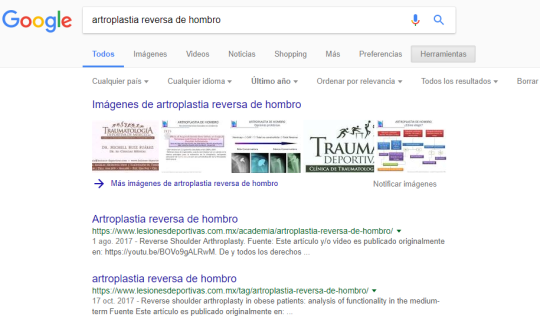miércoles, 29 de noviembre de 2017
EXPOSICION DEL GLENOIDES EN LA ARTROPLASTIA TOTAL DEL HOMBRO
GLENOID EXPOSURE IN TOTAL SHOULDER ARTHROPLASTY
Fuente
Este artículo es originalmente publicado en:
De:
2017 Nov 16. pii: S1877-0568(17)30323-7. doi: 10.1016/j.otsr.2017.10.008. [Epub ahead of print]
Todos los derechos reservados para:
Orthopaedics & Traumatology: Surgery & Research, Copyright © 2017
Copyright © 2017 Elsevier, Inc. All rights reserved.
Abstract
Glenoid exposure is agreed to be a difficult step, but is also a key step in total shoulderarthroplasty, both anatomic and reverse. It conditions unhindered use of the ancillary instrumentation and thus correct glenoid component positioning. The main stages comprise arthrotomy, by opening the rotator cuff, humeral head cut, and inferior glenohumeral release, enabling shifting of the humerus and good exposure of the glenoid cavity. The two main approaches are deltopectoral and anterosuperior transdeltoid. Using the deltopectoral approach, arthrotomy is performed through the subscapularis muscle, by various techniques. This approach enables extensive inferior glenohumeral release and thus an approach to the inferior apex of the glenoid cavity, which is a key area for glenoid implant positioning. The main drawbacks are postoperative shoulder instability and limited access to the posterior part of the glenoid in case of significant retroversion. Moreover, subscapularis healing is uncertain, which can impair the clinical outcomes, with risk of glenoid component loosening. Advantages, on the other hand, include the fact that it can be implemented in all cases, even the most difficult ones, and that the deltoid muscle is respected. The transdeltoid approach has the advantage of being simple, providing direct exposure of the glenoid cavity through a rotator cuff tear after passing through the deltoid. It is therefore especially indicated for reverse prosthesis in case of rotator cuff tear, and in traumatology. However, the approach to the inferior part of the glenoid cavity can be restricted, with insufficient exposure and a risk of glenoid component malpositioning (superior tilt). The preoperative assessment is essential, to detect at-risk situations such as severe stiffness and anticipate difficulties in glenoid exposure.
KEYWORDS:
Arthroplasty; Deltopectoral; Glenoid cavity; Shoulder; Transdeltoid
Resumen
La exposición glenoidea se considera un paso difícil, pero también es un paso clave en la artroplastia total del hombro, tanto anatómica como reversa. Condiciona el uso sin obstáculos de la instrumentación auxiliar y, por lo tanto, corrige el posicionamiento del componente glenoideo. Las etapas principales comprenden la artrotomía, al abrir el manguito de los rotadores, el corte de la cabeza del húmero y la liberación glenohumeral inferior, lo que permite el desplazamiento del húmero y una buena exposición de la cavidad glenoidea. Los dos abordajes principales son deltopectoral y anterosuperior transdeltoide. Usando el abordaje deltopectoral, la artrotomía se realiza a través del músculo subescapular, por diversas técnicas. Este abordaje permite una liberación glenohumeral inferior extensa y, por lo tanto, un acercamiento al ápice inferior de la cavidad glenoidea, que es un área clave para el posicionamiento de los implantes glenoideos. Los principales inconvenientes son la inestabilidad postoperatoria del hombro y el acceso limitado a la parte posterior de la cavidad glenoidea en caso de retroversión significativa. Además, la cicatrización del subescapular es incierta, lo que puede perjudicar los resultados clínicos, con riesgo de aflojamiento del componente glenoideo. Las ventajas, por otro lado, incluyen el hecho de que puede implementarse en todos los casos, incluso los más difíciles, y que se respeta el músculo deltoides. El abordaje transdeltoide tiene la ventaja de ser simple y proporciona una exposición directa de la cavidad glenoidea a través de una rotura del manguito rotador después de atravesar el deltoides. Por lo tanto, está especialmente indicado para prótesis reversas en caso de rotura del manguito de los rotadores y en traumatología. Sin embargo, el acceso a la parte inferior de la cavidad glenoidea puede restringirse, con una exposición insuficiente y un riesgo de mala posición del componente glenoideo (inclinación superior). La evaluación preoperatoria es esencial para detectar situaciones de riesgo como rigidez severa y anticipar dificultades en la exposición glenoidea.
PALABRAS CLAVE:
Artroplastia; Deltopectoral; Cavidad glenoidea; Hombro; Transdeltoide
PMID: 29155311 DOI: 10.1016/j.otsr.2017.10.008
Bloqueo epidural para ciática / The epidural block of sciatica
| ||||||||||||
martes, 28 de noviembre de 2017
Hepatitis viral y embarazo / Viral hepatitis in pregnancy. Yahoo / Buzón
| ||||||||||||||
Artritis reumatoide de la mano
http://www.clinicademano.com.mx/clinica-de-mano/artritis-reumatoide-de-la-mano/
Fuente
Este artículo y/o video es originalmente publicado en:
https://youtu.be/d6P0MCjz9T4
De y todos los derechos reservados para:
Dr. Ebraheim’s educational animated video describes the condition of rheumatoid arthritis, the etiology, signs and symptoms, the diagnostic tests and indications, and the treatment options and prognosis.
Rheumatoid Arthritis of the hand
Fuente
Este artículo y/o video es originalmente publicado en:
https://youtu.be/d6P0MCjz9T4
De y todos los derechos reservados para:
Dr. Ebraheim is the Chairman of Orthopaedics and the Director of the Orthopaedic Surgery Residency Program at the University of Toledo.
Dr. Ebraheim’s educational animated video describes the condition of rheumatoid arthritis, the etiology, signs and symptoms, the diagnostic tests and indications, and the treatment options and prognosis.
Become a friend on facebook:
Follow me on twitter:
Categoría
Licencia
Licencia estándar de YouTube
Suscribirse a:
Entradas (Atom)





